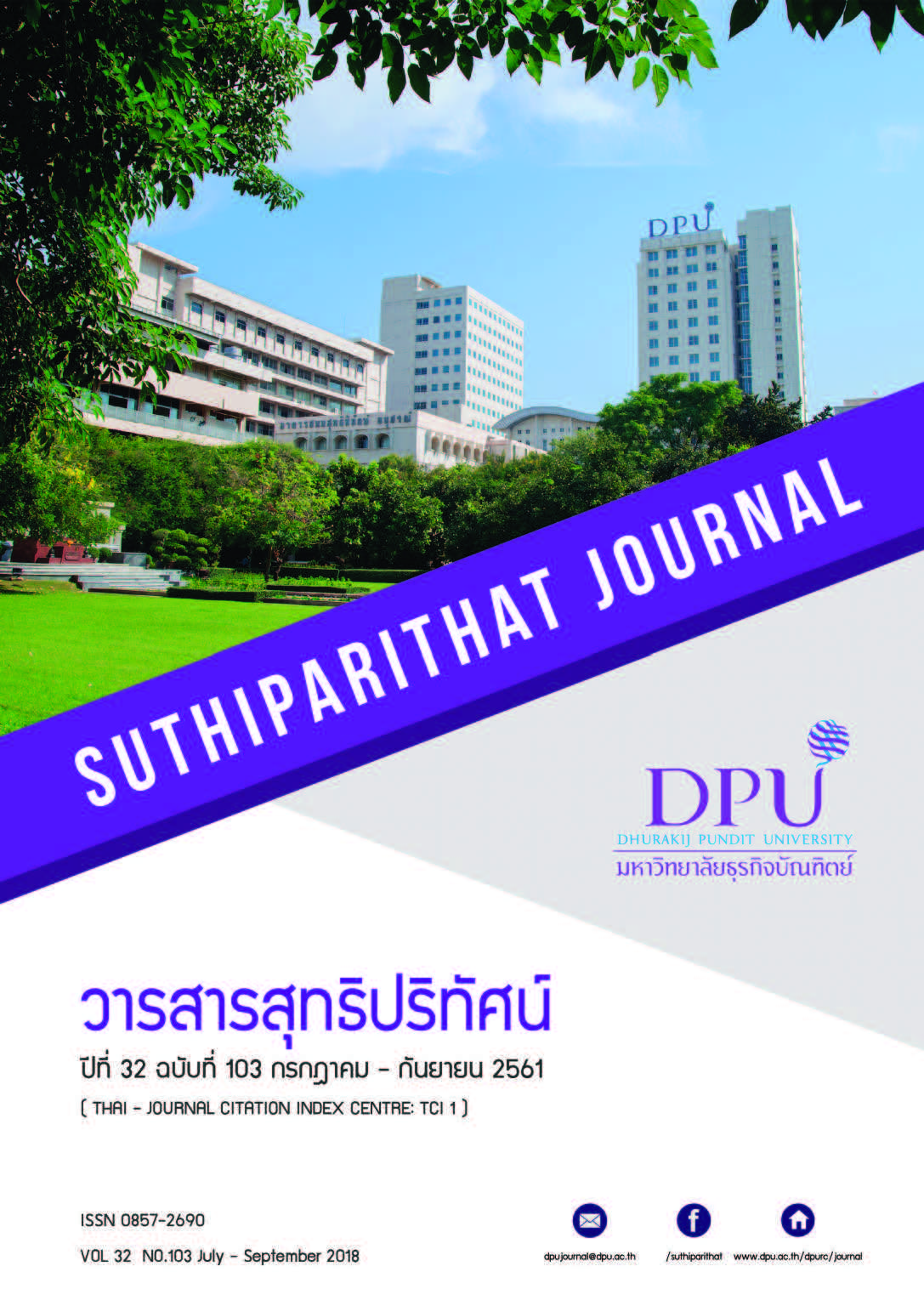ปัจจัยที่ส่งผลต่อพฤติกรรมการซื้อของนักท่องเที่ยวชาวอาเซียนในประเทศไทย
คำสำคัญ:
นักท่องเที่ยวชาวอาเซียนในประเทศไทย, พฤติกรรมการค้นหาข้อมูลด้วยสื่อสังคมออนไลน์, พฤติกรรมการซื้อของนักท่องเที่ยวบทคัดย่อ
ข้อมูลจากการท่องเที่ยวแห่งประเทศไทยระบุว่ามีจำนวนนักท่องเที่ยวจากประเทศอาเซียนที่เดิน ทางมาประเทศไทยเพิ่มขึ้นขึ้นอย่างตอ่ เนื่องถึง 8.6 ล้านคนในปี พ.ศ. 2559 ปรากฎการณ์นี้มีบทบาทสำคัญในการขับเคลื่อนอุตสาหกรรมเกี่ยวเนื่องอื่นๆ เช่น ธุรกิจการบิน และเศรษฐกิจของประเทศไทย เพื่อรักษาสภาวะเชิงบวกนี้ไว้ จึงอาจจำเป็นต้องศึกษาพฤติกรรมการซื้อและปัจจัยต่างๆ ที่มีอิทธิพลต่อพฤติกรรม การซื้อของนักท่องเที่ยวชาวอาเซียนในประเทศไทย เช่น ปัจจัยส่วนบุคคลและพฤติกรรมการค้นหาข้อมูลด้วยสื่อสังคมออนไลน์ งานวิจัยเชิงสำรวจนี้ใช้การสุ่มตัวอย่างแบบโควต้าและใช้แบบสอบถามในการเก็บข้อมูลจากนักท่องเที่ยวชาวอาเซียนในประเทศไทยจำนวน 100 คนจาก 5 ประเทศ ได้แก่ กัมพูชา ลาว เมียนมาร์ มาเลเซีย และฟิลิปปินส์ ทำการวิเคราะห์ข้อมูลโดยใช้สถิติพรรณนาและทดสอบสมมติฐานโดยใช้สถิติไคสแควร์ (X2-test)
ผลจากการวิจัยพบว่าผู้ตอบแบบสอบถามส่วนใหญ่มีสถานภาพโสด เป็นเพศหญิง และมีรายได้เฉลี่ยต่อเดือนอยู่ที่ 500-1,000 ดอลล่าร์สหรัฐอเมริกา ผลการทดสอบสมมติฐานพบว่า นักท่องเที่ยวชาว อาเซียนที่มีความแตกต่างกันในด้านประชากรศาสตร์ เช่น เพศ อายุ และเชื้อชาติจะมีพฤติกรรมการ การซื้อขณะท่องเที่ยวที่แตกต่างกัน เช่น ระยะเวลาที่พักและค่าใช้จ่ายเฉลี่ยต่อครั้ง นอกจากนี้ยังพบว่า มี ความสัมพันธ์ระหว่างพฤติกรรมการค้นหาข้อมูลโดยใช้สื่อสังคมออนไลน์ (เฟสบุ้คและอินสตาแกรม) และ พฤติกรรมการท่องเที่ยวของนักท่องเที่ยวชาวอาเซียนในประเทศไทยอย่างมีนัยสำคัญทางสถิติที่ระดับ 0.05
เอกสารอ้างอิง
Arnould, E., Price, L., & Zinkhan, G. (2002), Consumers. (1st edition). McGrawHill.
ASEAN up (2018). Southeast Asia digital, social and mobile 2018. Retrieved January 10, 2018, from https://aseanup.com/southeast-asia-digital-social-mobile/
Ayda, D. & Wei, L. (2012). The impact of online social networks on consumers’ purchasing decision. Retrieved January 10, 2018, from www.diva-portal.org/smash/get/diva2:5320249.
Bangkok Post. (2017). Thailand tourism healthy. Retrieved January 10, 2018 from https://www.bangkokpost.com/travel/tourists-and-expats/1319947/thailand-tourism-healthy
Bilal, G., Ashfaq, A. M., and Shahzad, M. N. (2014). Role of Social Media and Networks in Consumer Decision Making: A case of the garment sector. International Journal of Multidisciplinary Sciences and Engineering, 5(3), 1-9
Cox, C., Burgess, S., Sellitto, C., and Buultjens, J. (2009). The Role of User-Generated Content in Tourists’ Travel Planning Behavior. Journal of Hospitality Marketing & Management, 18(8), 743-764.
Chang, J. (2006). Segmenting tourists to aboriginal cultural festivals: An example in the Rukai tribal area, Taiwan, Tourism management, 27(6), 1224-1234
De Valck, K., Van Bruggen, G., and Wierenga, B. (2009). Virtual communities: A marketing perspective. Decision Support Systems, 47(3), 185-203.
Fischer, E. and Reuber, A. R. (2011). Social interaction via new social media: (How) can interactions on Twitter affect effectual thinking and behavior? Journal of Business Venturing, 26(1), 1-18.
Foxall, G. R., and Sigurdsson, V. (2013). Introduction to the Special Issue: Consumer Behavior Analysis: Behavioral Economics Meets the Marketplace. The Psychological Record, 63(2), 231-238
Goodall, B., & Ashworth, G. (1988). Marketing in the tourism industry. United Kingdom: Croom Helm.
Hammonds-Smith, M., Courtless, J.C., and Schwenk, F.N., (1992). A Comparison of Income, Income Sources, and Expenditures of Older Adults by Educational Attainment. Family Economic Review, 5(4), 2–8.
Hawkins, D, Best, R., and Coney, K. (2004), Consumer Behavior. (9th edition). McGrawHill.
Jansen, B. J., Zhang, M., Sobel, K. and Chowdury, A. (2009). Twitter power: Tweets as electronic word of mouth. Journal of the American Society for Information Science & Technology, 60(11), 2169-2188.
Kaplan, A.M. and Haenlein, M. (2010). Users of the world, unite! The challenges and opportunities of social media. Business Horizons, 53(1), 59-68.
Kim, W. G., Jeong, O. R. and Lee, S. W. (2010). On social Web sites. Information Systems, 35(2), 215-236.
Kiráľová, A., and Pavlíčeka, A. (2015). Development of social media strategies in tourism destination. Procedia-Social and Behavioral Sciences, 175, 358-366.
Kuruk K. (2007). An analysis of consumer power on the Internet. Technovation, 27 (1–2), 47–56.
Kotler, P. (2003). Marketing Management. (12th edition). Singapore: Pearson Education Asia.
Kotler, P., and Keller, K. (2006). Marketing management (12th edition). Upper Saddle River, NJ: Prentice Hall.
Kotler, P., Armstrong, G., Wong, V., and Saunders, J. (2008). Principles of Marketing. Harlow: Pearson Education
Languepin, O. (2017). Thailand Tourism: Analysts forecast up to 37 million arrivals in 2017. Retrieved January 11, 2018, from https://www.thailand-business-news.com/tourism/55012-thailand-tourism-analysts-forecast-37-million-arrivals-2017.html
Mowen, J.C. (1995). Consumer Behaviour. (4th edition). New Jersey: Prentice - Hall.
Neti, S. (2011). International Journal of Enterprise Computing And Business Systems 2011. Social Media and its Role in Marketing, 1(2), 1-9.
Nongbunnak, S., Yang, C., Wairangkoon, S., and Na Ubon, A. (2018). Chinese Students’ Satisfaction Toward Studying in Chinese Programs at Thai Universities. Proceeding of the 5th Global Advanced Research Conference on Management and Business Studies, 34
Nop, S., Nongbunnak, S., Narula, R., and Kongpolphrom, P. (2018). Quality of Life: A Study of Cambodian Migrant Workers in Thailand. Proceeding of the 5th Global Advanced Research Conference on Management and Business Studies, 78
Opperman, M., (1995). A model of travel itineraries. Journal of Travel Research, 33(4), 57-61.
Romsa, G. and Blenman, M. (1989). Visitor patterns of elderly Germans. Annals of Tourism Research, 16, 178-188.
Schhiffman, J. B. and Lazar, K. L. (1997) Consumer Behavior. (6th edition). Prentice Hall.
Sheldon, P.J. and Mak, J. (1987). The demand for package tours: A mode choice model. Journal of Travel Research, 25 (3), 13-17.
Stankov, U., Lazić, L. and Dragićević, V. (2010). The extent of use of basic Facebook usergenerated content by the national tourism organizations in Europe. European Journal of Tourism Research, 3(2), 105-113.
Sritama, S. (2017a, October 9). Making tourism sustainable. Bangkok Post. Retrieved January 11, 2018, from https://www.bangkokpost.com/business/news/1339179/making-tourism-sustainable
Sritama, S. (2017b, January 19). Thailand unveils campaign to attract tourists from Asean nations.The Nation. Retrieved January 11, 2018, from http://www.nationmultimedia.com/news/business/EconomyAndTourism/30304405
Svasti. P. (2012). Thai tourism biz goes digital. Bangkok Post. Retrieved January 11, 2018 from https://www.bangkokpost.com/tech/gadget/328072/thai-tourism-biz-goes-digital
Tabachnick, B. G., and Fidell, L. S. (2007). Using Multivariate Statistics (5th edition.). New York: Allyn and Bacon.
Tourism Authority of Thailand (Producer). (10 October 2017). Thailand’s tourist arrivals and revenue continues growth in 3rd Quarter of 2017. Retrieved January 11, 2018, from https://www.tatnews.org/thailands-tourist-arrivals-and-revenue-continues-growth-in-3rd-quarter-of-2017/
Vilčeková, L., and Sabo, M. (2013). The influence of demographic factors on attitudes toward brands and brand buying behavior of Slovak consumers. International Journal of Education and Research, 1 (11), 1-10.
Weagley, R. O., and Huh, E. (2004).The Impact of Retirement on Household Leisure Expenditures. The Journal of Consumer Affairs, 38(2), 262-281
Weaver, P. A., McCleary, K. W., Lepisto, L., and Damonte, L. T. (1994). The relationship of destination selection attributes to psychological, behavioural and demographic variables. Journal of Hospitality and Leisure Marketing, 2 (2), 93-109.
White, L. (2010). Facebook, Friends and Photos: A Snapshot into Social Networking for Generating Travel Ideas. In: Sharda, N., ed. Tourism Informatics: Visual Travel Recommender Systems, Social Communities, and User Interface Design. Hershey. NY: IGI Global, 115-129.
World Tourism Organization. (2017). 2017 Annual Report. Retrieved January 11, 2018, from https://www.eunwto.org/doi/pdf/10.18111/9789284419807
Yamane, T. (1967). Statistics: An Introductory Analysis, (2nd Edition). New York: Harper and Row.
ดาวน์โหลด
เผยแพร่แล้ว
รูปแบบการอ้างอิง
ฉบับ
ประเภทบทความ
สัญญาอนุญาต
เนื้อหาและข้อมูลในบทความที่ลงตีพิมพ์ในวารสารสุทธิปริทัศน์ ถือเป็นข้อคิดเห็นและความรับผิดชอบของผู้เขียนบทความโดยตรงซึ่งกองบรรณาธิการวารสาร ไม่จำเป็นต้องเห็นด้วย หรือร่วมรับผิดชอบใด ๆ
บทความ ข้อมูล เนื้อหา รูปภาพ ฯลฯ ที่ได้รับการตีพิมพ์ในวารสารสุทธิปริทัศน์ ถือเป็นลิขสิทธิ์ของวารสารสุทธิปริทัศน์หากบุคคลหรือหน่วยงานใดต้องการนำทั้งหมดหรือส่วนหนึ่งส่วนใดไปเผยแพร่ต่อหรือเพื่อกระทำการใด ๆ จะต้องได้รับอนุญาตเป็นลายลักษณ์อักษรจากวารสารสุทธิปริทัศน์ก่อนเท่านั้น







